Distributed Prediction-Enhanced Beamforming Using LR/SVR Fusion and MUSIC Refinement in 5G O-RAN Systems
Abstract
1. Introduction
- Parallel distributed prediction architecture: We uniquely leverage the O-RAN Split 7-2x architecture to distribute prediction tasks. Lightweight LR inference is executed at the O-RU for immediate slot-level responsiveness, while adaptive, curvature-aware SVR is performed at the O-DU. This parallel dual-pipeline eliminates the latency overhead and instability associated with switching between reactive or sequential models.
- Dominance-Enforced Adaptive Clustered Sliding Window Fusion (DE-ACSW-R): Our core innovation is a mathematically novel fusion framework that (1) detects sharp AoA jumps within the sliding prediction window and clusters (selects) only post-jump samples for subsequent regression and SVR inference, maximising reliability after rapid trajectory changes, and also (2) applies a dynamic, dominance-enforced fusion rule: the fused AoA prediction is weighted toward the model (LR or SVR) that exhibits the lowest MSE against the most recent ground truth, with a “dominance-enforced” override when there is a clear performance gap.
- Curvature-adaptive SVR kernel: We introduce a dynamic SVR kernel-width adaptation strategy, where the Gaussian width (σ) is modulated by real-time AoA trajectory curvature. This enables highly responsive and robust prediction under non-linear or unpredictable mobility.
- Autonomous MUSIC-based fallback: When a jump is detected or when the confidence in prediction drops, the O-RU autonomously triggers a localised high-speed MUSIC scan, refining AoA estimation within a reduced angular search space. This approach enables a rapid and robust recovery without the cost of a full-spectrum search.
2. Related Work
3. Proposed Solution to Predict the AoA
3.1. System Overview and Assumptions
- The O-DU lacks an immediate physical-layer awareness of rapid changes at the O-RU.
- Codebook-based beam selection often underperforms in multipath and NLoS (non-line-of-sight) conditions.
3.1.1. 3GPP Beamforming Limitations
- Immediate low-latency AoA adjustment at the RU for fast mobility or sudden AoA jumps;
- Continuous validation, correction, or fusion of predictions at the DU for robustness and overall performance.
- The O-RU performs real-time AoA tracking using a jump-aware, clustered, WLR model. Upon detecting an abrupt AoA jump within the window, the O-RU recentres its prediction on the most recent (post-jump) samples to maximise its responsiveness to non-linear user mobility.
- The O-RU maintains per-user AoA history buffers and precomputes beamforming weights for the predicted angles, ensuring slot-level adaptation and low-latency response.
- Concurrently, the O-DU executes a curvature-adaptive SVR prediction process using a broader AoA history, real-time SNR, and physical and statistical confidence metrics. The O-DU can override, validate, or dynamically fuse O-RU predictions using a dominance-enforced logic that always selects the most reliable predictor based on windowed mean squared error (MSE).
- At every slot boundary, the O-RU transmits updated AoA histories to the O-DU. The O-DU replies with either a dynamically fused AoA prediction (a dominance-enforced confidence-curvature-weighted combination of LR and SVR, or an explicit override/fallback command if low confidence or outlier behaviour is detected).
3.1.2. Key Technical Contributions
- Parallel distributed inference: The system executes lightweight Weighted LR prediction at the O-RU (for immediate reaction) and advanced curvature-adaptive SVR at the O-DU (for robust, longer-term modelling), running in true parallel to eliminate the inherent latency of reactive model switching.
- Dominance-enforced confidence–curvature weighted fusion: LR and SVR predictions are fused in real-time via a dynamic weighting algorithm that incorporates statistical spread (confidence), trajectory curvature, and instantaneous windowed prediction error. Whenever a clear winner is present (as determined by MSE), the fusion “dominance-enforced” overrides the privileges of that predictor, ensuring that the most reliable result drives beam updates at each slot.
- Autonomous MUSIC-based fallback: Upon detection of a sharp AoA jump or drop in prediction confidence, the O-RU immediately triggers a localised MUSIC estimation within a reduced angular sector, providing rapid and robust AoA refinement and protecting against outlier or adversarial conditions.
- Jump-aware window clustering: When sudden AoA jumps are detected within the sliding window, the regression window is split, and predictions are recalculated only on the most recent post-jump segment, reducing prediction error during abrupt trajectory changes.
- Modular and practical integration: The prediction architecture is fully modular and designed for seamless integration with standard O-DU scheduling and control logic. No changes are required at the O-RU’s hardware level, facilitating practical adoption and interoperability within existing O-RAN deployments.
3.2. Predictive AoA Framework and Decision Logic
3.3. System Model and Mathematical Formulation
3.3.1. System Geometry and Architecture
3.3.2. Predictive Signal Model Under User Mobility
3.3.3. Snapshot Matrix and Predictive Normalisation
3.3.4. Predictive AoA Models (DE-ACSW-R)
- Weighted and Clustered Linear Regression for Predictive AoA Estimation
- Weighted Linear Regression (WLR) Extension
- Adaptive Clustered Sliding Window Regression (Jump Detection)
- If for some k in the window, then only the samples after the last jump (i.e., from ) are used in the weighted regression.
- If no jump is detected, the entire window is used.
- Linear Regression-based AoA prediction relies on the following assumptions:
- Short-term linear trend: The AoA trajectory over the prediction window is approximately linear, valid for low-speed UEs or over short time scales.
- Stationarity within window: The angular velocity remains roughly constant within the window, W.
- High-quality historical AoAs: The recent AoA estimates are accurate and not corrupted by multipath-induced ambiguity or outliers.
- The enhanced MUSIC module, which constrains its angular search window using .
- The confidence-weighted fusion logic blends it with SVR-based predictions for robust output.
- Support Vector Regression (SVR) for Non-Linear AoA Prediction
- Non-linear or curved mobility patterns, such as turns, roundabouts, or urban obstacles.
- Multipath-dominated environments, where reflection-induced AoA shifts create non-monotonic signal behaviour.
- Longer-term history exploitation, where patterns are not well approximated by short-window linear trends.
- Curvature-Adaptive Kernel for Non-Linear Mobility
- Maintain prediction robustness across time-varying dynamics;
- Inform the confidence-weighted fusion module of trajectory nonlinearity, enhancing global prediction quality;
- Reduce fallback events by improving prediction precision in conditions where LR fails due to curvature;
- Operate asynchronously while allowing for the RU to continue local operations.
- Adaptive Dynamic Fusion of LR and SVR Predictions (DE-ACSW-R Fusion)
- Smooth, adaptive transitions between LR and SVR predictions without abrupt switching.
- Robustness to abrupt mobility changes as the fusion rapidly increases the influence of the more reliable predictor.
- Physical-layer awareness is achieved by optionally incorporating SNR or error statistics in the weighting logic.
- If LR is more accurate ():
- ○
- ○
- If LR is more accurate ():
- ○
- ○
3.3.5. Enhanced MUSIC AoA Estimation with Predictive Window Constraints
3.3.6. Confidence-Driven MUSIC Fallback Mechanism
- Fallback Triggering Conditions
- Low Prediction Confidence
- Abrupt AoA Discontinuity (Jump Detection)
- Prediction Residual Thresholding
- All fallback logic, confidence calculations, and jump detections operate at the O-RU level, and no O-DU or RIC interventions are required.
- Fallback decisions are updated slot-by-slot, ensuring rapid adaptation to dynamic propagation conditions.
- When the fallback AoA is obtained, it is immediately used to update steering vectors and realign the beam.
- The updated AoA is reinserted into the O-RU’s history window, enabling the seamless recovery and transition back to predictive operation.
3.4. Beamforming and Precoding Strategy
3.4.1. Beamforming Weight Computation Using Predicted AoA
3.4.2. Multi-User Beamforming and Interference Management
3.4.3. Predictive Precoding with Slot-Level Responsiveness
3.4.4. Practical Considerations for O-RAN Integration
- At the O-RU, a rapid generation of beamforming weights using LR-based AoA predictions, jump-detection clustering, and enhanced MUSIC (with window constraints) allows for near-instantaneous adaptation at the network edge.
- At the O-DU, longer-term refinement based on curvature-adaptive SVR, confidence-weighted fusion, and user classification can be sent to the O-RU for synchronised future-slot updates over eCPRI.
- Slot-to-Slot Update Capability offers beam weight updates at each TTI based on the most recent DE-ACSW-R prediction or MUSIC result, maintaining a rapid response in mobile scenarios.
3.4.5. Robustness to Prediction Error
- Fallback AoA estimation: When prediction confidence falls below the threshold, or an AoA jump is detected (as per DE-ACSW-R logic), the O-RU triggers a localised or full MUSIC scan, restoring alignment using direct subspace estimation.
- Beam width adjustment: Upon low confidence, the beam pattern is widened via tapering (e.g., Taylor window), sacrificing some gain to improve coverage and avoid mis-steering.
- SNR and SINR monitoring: Continuous monitoring of received SNR/SINR informs both prediction window size and beam pattern adaptation, increasing system resilience in rapidly changing conditions.
4. Simulation Setup and Parameters
4.1. Channel and Interference Modelling
4.2. Mobility and User Behaviour Models
4.3. Antenna Array and System Parameters
4.4. Predictive Beamforming, DE-ACSW-R, and System Integration
4.5. Performance Metrics
5. Simulation Results and Discussion
5.1. Model Adaptation Logic and Window Clustering Behaviour
- Window AoA: The blue points and line indicate the sequence of recent AoA measurements (window history), which the model uses for prediction.
- Full LR fit and prediction: The blue dashed line is the Linear Regression fit across the full window. The corresponding blue dot at index 6 is the predicted AoA for the next time slot, assuming no change in trajectory.
- Jump detection and clustering: At window index 4, the model detects a sudden, significant change in AoA identified as a trajectory jump. The DE-ACSW-R logic immediately re-clusters the window, discarding older points that do not reflect the new direction.
- Clustered LR fit and prediction: The red dashed-dotted line represents the LR fit applied only to the most recent cluster of AoA points after the jump. The red square at index 6 is the resulting predicted AoA for the next slot, based solely on the recent post-jump samples.
- When the trajectory is smooth, the model uses the full window to fit and predict the next AoA, leveraging maximum history for noise averaging.
- Upon detecting a jump, the window is clustered so that only the recent (relevant) points influence the LR fit and prediction. This avoids “lag” and prevents stale trajectory data from biassing the result.
- The clustered LR fit and its prediction are visibly better aligned with the new AoA trend than the full-window fit, demonstrating the model’s ability to adapt in real-time.
5.2. Baseline Model Performance and Comparative Analysis with the DE-ACSW-R Model
- Faster adaptation after abrupt mobility changes due to window clustering and dominance-enforced fusion.
- Reduced prediction error and variance during both linear and non-linear segments, owing to smooth confidence-weighted transitions between models.
- Increased robustness to outliers and history contamination by actively re-centring on relevant trajectory clusters after a jump.
5.3. Prediction-Aided Fallback and Beam Alignment Behaviour
5.4. SNR Performance: Robustness Under Mobility and Prediction Failures
6. Conclusions
Author Contributions
Funding
Informed Consent Statement
Data Availability Statement
Conflicts of Interest
References
- 3GPP TS 38.214 V16.7.0; NR; Physical Layer Procedures for Data; 3rd Generation Partnership Project (3GPP), 2020. Available online: https://portal.3gpp.org/desktopmodules/Specifications/SpecificationDetails.aspx?specificationId=3216 (accessed on 10 March 2024).
- Giordani, M.; Polese, M.; Mezzavilla, M.; Rangan, S.; Zorzi, M. Toward 6G Networks: Use Cases and Technologies. IEEE Commun. Mag. 2020, 58, 55–61. [Google Scholar] [CrossRef]
- Restuccia, F.; D’Oro, S.; Melodia, T. Deep Learning for Wireless Communications: A Comprehensive Survey. IEEE Commun. Surv. Tutor. 2019, 21, 3131–3168. [Google Scholar]
- Giordani, M.; Polese, M.; Roy, A.; Castor, D.; Zorzi, M. A Tutorial on Beam Management for 3GPP NR at mmWave Frequencies. IEEE Commun. Surv. Tutor. 2019, 21, 173–196. [Google Scholar] [CrossRef]
- Polese, M.; Bonati, L.; D’Oro, S.; Basagni, S.; Melodia, T. Understanding O-RAN: Architecture, Interfaces, Algorithms, Security, and Research Challenges. IEEE Commun. Surv. Tutor. 2023, 25, 1376–1411. [Google Scholar] [CrossRef]
- Ahmed, A.U.; Arablouei, R.; de Hoog, F.; Kusy, B.; Jurdak, R.; Bergmann, N. Estimating Angle of Arrival and Time of Flight for Multipath Components Using WiFi Channel State Information. Sensors 2018, 18, 1753. [Google Scholar] [CrossRef] [PubMed]
- TR 38.816 v15.0.0; Study on CU-DU Lower Layer Split for NR; 3rd Generation Partnership Project (3GPP); 2017. Available online: https://portal.3gpp.org/desktopmodules/Specifications/SpecificationDetails.aspx?specificationId=3364 (accessed on 10 March 2024).
- Elbir, A.M.; Mishra, K.V.; Vorobyov, S.A.; Heath, R.W. Twenty-Five Years of Advances in Beamforming: From convex and nonconvex optimization to learning techniques. IEEE Signal Process. Mag. 2023, 40, 118–131. [Google Scholar] [CrossRef]
- Brik, B.; Chergui, H.; Zanzi, L.; Devoti, F.; Ksentini, A.; Siddiqui, M.S.; Costa, X.; Verikoukis, C. Explainable AI in 6G O-RAN: A Tutorial and Survey on Architecture, Use Cases, Challenges, and Future Research. arXiv 2023, arXiv:2307.00319. [Google Scholar] [CrossRef]
- RAN. WG2.AIML-v02.00; AI/ML Workflow Description and Requirements; O-RAN Alliance: Alfter, Germany, 2022. [Google Scholar]
- Lafta, N.A.; Hreshee, S.S. Wireless sensor network’s localization based on multiple signal classification algorithm. Int. J. Electr. Comput. Eng. 2021, 11, 498–507. [Google Scholar] [CrossRef]
- Yeh, S.; Bhattacharya, S.; Sharma, R.; Moustafa, H. Deep Learning for Intelligent and Automated Network Slicing in 5G Open RAN (O-RAN) Deployment. IEEE Open J. Commun.Soc. 2023, 4, 333785. [Google Scholar] [CrossRef]
- Saad, S.A.; Shayea, I.; Sid Ahmed, N.M.O. Artificial intelligence linear regression model for mobility robustness optimization algorithm in 5G cellular networks. Ain Shams Eng. J. 2024, 15, 101609. [Google Scholar] [CrossRef]
- Möhring, L.; Gläscher, J. Prediction errors drive dynamic changes in neural patterns that guide behawior. Cell Rep. 2023, 42, 2023. [Google Scholar] [CrossRef] [PubMed]
- Rahil; Mbarek, N.; Togni, O.; Atieh, M.; Fouladkar, A. Statistical learning and multiple linear regression model for network selection using MIH. In Proceedings of the 3rd International Conference on e-Technologies and Networks for Development (ICeND2014), Beirut, Lebanon, 29 April–1 May 2014; pp. 189–194. [Google Scholar] [CrossRef]
- Kavitha, S.; Varuna, S.; Ramya, R. A comparative analysis on linear regression and support vector regression. In Proceedings of the Online International Conference on Green Engineering and Technologies (IC-GET), Coimbatore, India, 19 November 2016; pp. 1–5. [Google Scholar] [CrossRef]
- Wang, J.; Chen, Y.; Chen, S. SVR-based user mobility prediction with curvature-adaptive kernel. In Proceedings of the 2022 IEEE International Conference on Communications (ICC 2022), Seoul, Republic of Korea, 16–20 May 2022. [Google Scholar]
- Yin, H.; Liu, Y.; Chen, M.; Wang, L. Machine Learning for Beam Prediction in 5G NR Systems. IEEE Trans. Wirel. Commun. 2021, 20, 8320–8332. [Google Scholar]
- Bonati, L.; D’Oro, S.; Polese, M.; Basagni, S.; Melodia, T. Intelligence and Learning in O-RAN for Data-Driven NextG Cellular Networks. IEEE Commun. Mag. 2023, 59, 21–27. [Google Scholar] [CrossRef]
- Spanos, T.; Ntontin, K.; Alexiou, A. Angle of Arrival Estimation Using SRS in 5G NR Uplink Scenarios. arXiv 2024, arXiv:2411.16501. [Google Scholar]
- Biswas, R.; Routray, A.; Chakraborty, S. Resolution limit of 2D MUSIC in near-field source localization. In Proceedings of the IECON 2019—45th Annual Conference of the IEEE Industrial Electronics Society, Lisbon, Portugal, 14–17 October 2019; pp. 156–160. [Google Scholar] [CrossRef]
- Li, C.; Mei, X. Application of SVR models built with AOA and Chaos mapping for predicting tunnel crown displacement induced by blasting excavation. Appl. Soft Comput. 2023, 147, 110808. [Google Scholar] [CrossRef]
- Marenco; Hupalo, L.E.; Andrade, N.F.; Figueiredo, F.A.P. Machine-learning-aided method for optimizing beam selection and update period in 5G networks and beyond. Sci. Rep. 2024, 14, 20103. [Google Scholar] [CrossRef]
- Muhammad, Q.K.; Abdo, G.; Mohammad, P.; Philipp, S.; Gerhard, F. A Low-Complexity Machine Learning Design for mmWave Beam Prediction. arXiv 2023, arXiv:2310.19323. [Google Scholar]
- Liu, S.; Li, X.; Mao, Z.; Liu, P.; Huang, Y. Model-driven deep neural network for enhanced AoA estimation using 5G gNB. In Proceedings of the AAAI Conference on Artificial Intelligence, Vancouver, BC, Canada, 20–27 February 2024; Volume 38, pp. 5477–5485. [Google Scholar]
- Batalla, J.M.; de la Cruz Llopis, L.J.; Gómez, G.P.; Andrukiewicz, E.; Krawiec, P.; Mavromoustakis, C.X.; Song, H. Multi-Layer Security Assurance of the 5G Automotive System Based on Multi-Criteria Decision Making. IEEE Trans. Intell. Transp. Syst. 2024, 25, 3496–3512. [Google Scholar] [CrossRef]
- RAN. WG1-ARCH-Overview, v5.00; O-RAN Architecture Description; O-RAN Alliance: Alfter, Germany, 2023. [Google Scholar]
- RAN. WG4.CUS.0-v06.00; O-RAN Front Haul Working Group: Control, User and Synchronization Plane Specification; O-RAN Alliance: Alfter, Germany, 2021. [Google Scholar]
- RAN. WG5.TS.C.1-R004-v14.00; O-RAN Open F1/W1/E1/X2/Xn Interfaces Working Group, NR C-plane profile; O-RAN Alliance: Alfter, Germany, 2025. [Google Scholar]
- Shu, F.; Yang, L.; Wang, Y.; Wang, X.; Shi, W.; Shen, C.; Wang, J. Precoding and Beamforming Design for Intelligent Reconfigurable Surface–Aided Hybrid Secure Spatial Modulation. arXiv 2023, arXiv:2302.07564. [Google Scholar] [CrossRef]
- RAN. WG4.MP.0-R003-v14.00, O-RAN Management Plane Specification 14.0; O-RAN Alliance: Alfter, Germany, 2024. [Google Scholar]
- TR 38.912 version 14.0.0 Release 14; 5G; Study on New Radio (NR) Access Technology; 3rd Generation Partnership Project (3GPP), 2017. Available online: https://portal.3gpp.org/desktopmodules/Specifications/SpecificationDetails.aspx?specificationId=3059 (accessed on 10 March 2024).
- Krishnaveni, V.; Kesavamurthy, T.; Aparna, B. Beamforming for Direction-of-Arrival (DOA) Estimation-A Survey. Int. J. Comput. Appl. 2013, 61, 4–11. [Google Scholar] [CrossRef]
- TS 38.213 V16.6.0, NR; Physical Layer Procedures for Control. 3rd Generation Partnership Project (3GPP), 2020. Available online: https://portal.3gpp.org/desktopmodules/Specifications/SpecificationDetails.aspx?specificationId=3215 (accessed on 10 March 2024).
- TS 38.211 V16.5.0; NR; Physical Channels and Modulation. 3rd Generation Partnership Project (3GPP), 2020. Available online: https://portal.3gpp.org/desktopmodules/Specifications/SpecificationDetails.aspx?specificationId=3213 (accessed on 10 March 2024).
- RAN Alliance, O-RAN Minimum Viable Plan and Acceleration Towards Commercialization, White Paper, June 2021. Available online: https://mediastorage.o-ran.org/white-papers/O-RAN.Minimum-Viable-Plan-and-Acceleration-towards-Commercialization-white-paper-2021-06.pdf (accessed on 10 March 2024).
- Azariah, W.; Bimo, F.A.; Lin, C.-W.; Cheng, R.-G.; Nikaein, N.; Jana, R. A Survey on Open Radio Access Networks: Challenges, Research Directions, and Open Source Approaches. Sensors 2024, 24, 1038. [Google Scholar] [CrossRef]
- Henninger, M.; Mandelli, S.; Arnold, M.; Brink, S.T. A Computationally Efficient 2D MUSIC Approach for 5G and 6G Sensing Networks. arXiv 2021, arXiv:2104.15132. [Google Scholar]
- Li, C.; Wang, J.; Shim, B. Learning-Based Beam Management for mmWave Massive MIMO Systems. IEEE Trans. Commun. 2022, 70, 3129–3143. [Google Scholar]
- Mayyahi, M.; Batalla, J.M.; Mavromoustakis, C.X. Enhancing adaptive beamforming by enhanced MUSIC algorithm for urban environments in O-RAN architecture. EURASIP J. Wirel. Commun. Netw. 2025, 2025, 1–44. [Google Scholar] [CrossRef]
- Mohsin, M.; Batalla, J.M.; Pallis, E.; Mastorakis, G.; Markakis, E.; Mavromoustakis, C.X. On Analyzing Beamforming Implementation in O-RAN 5G. Electronics 2021, 10, 2162. [Google Scholar] [CrossRef]
- Batalla, J.M.; Moshin, M.; Mavromoustakis, C.X.; Wesołowski, K.; Mastorakis, G.; Krzykowska-Piotrowska, K. On deploying the Internet of Energy with 5G Open RAN technology including beamforming mechanism. Energies 2022, 15, 2429. [Google Scholar] [CrossRef]

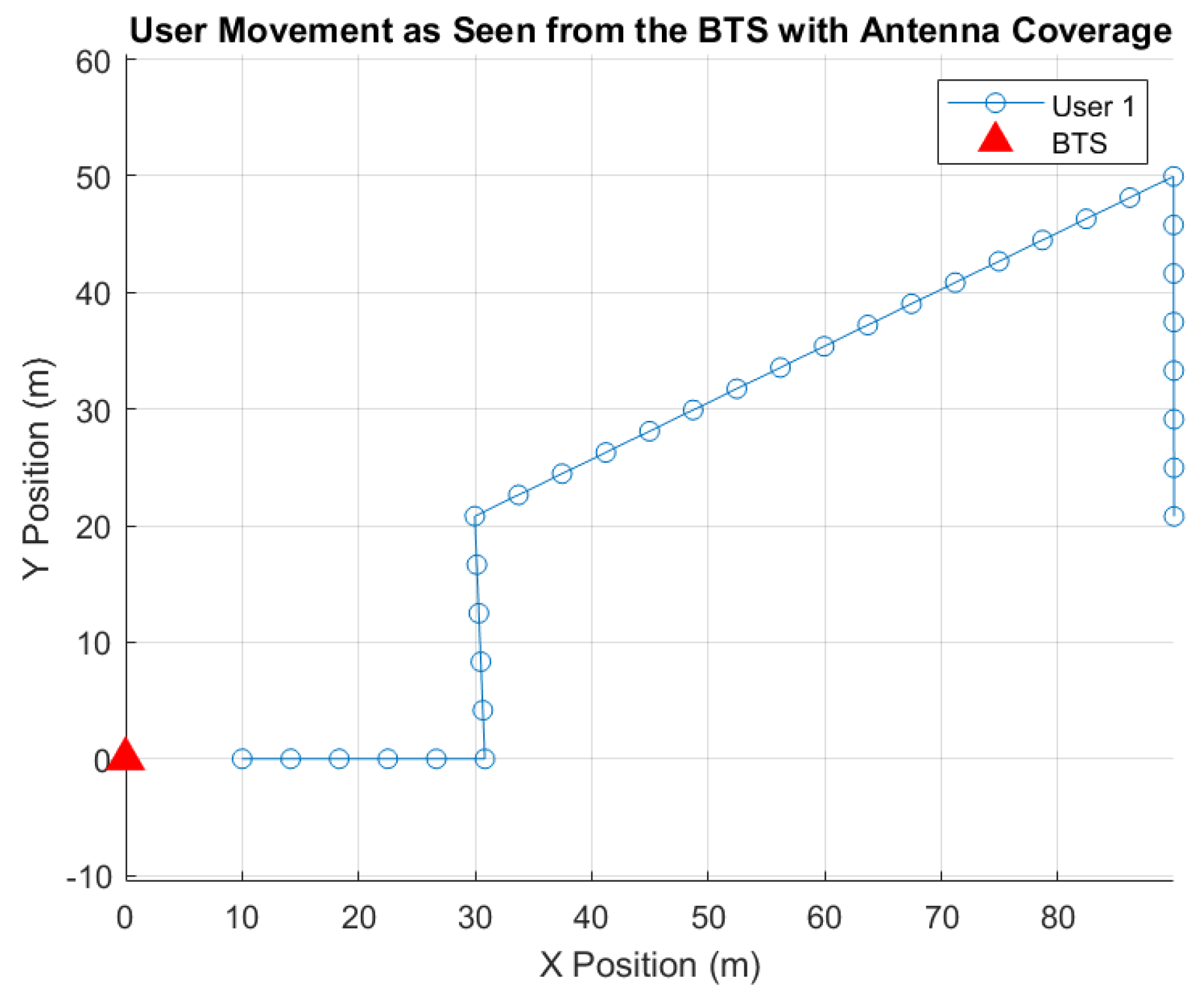
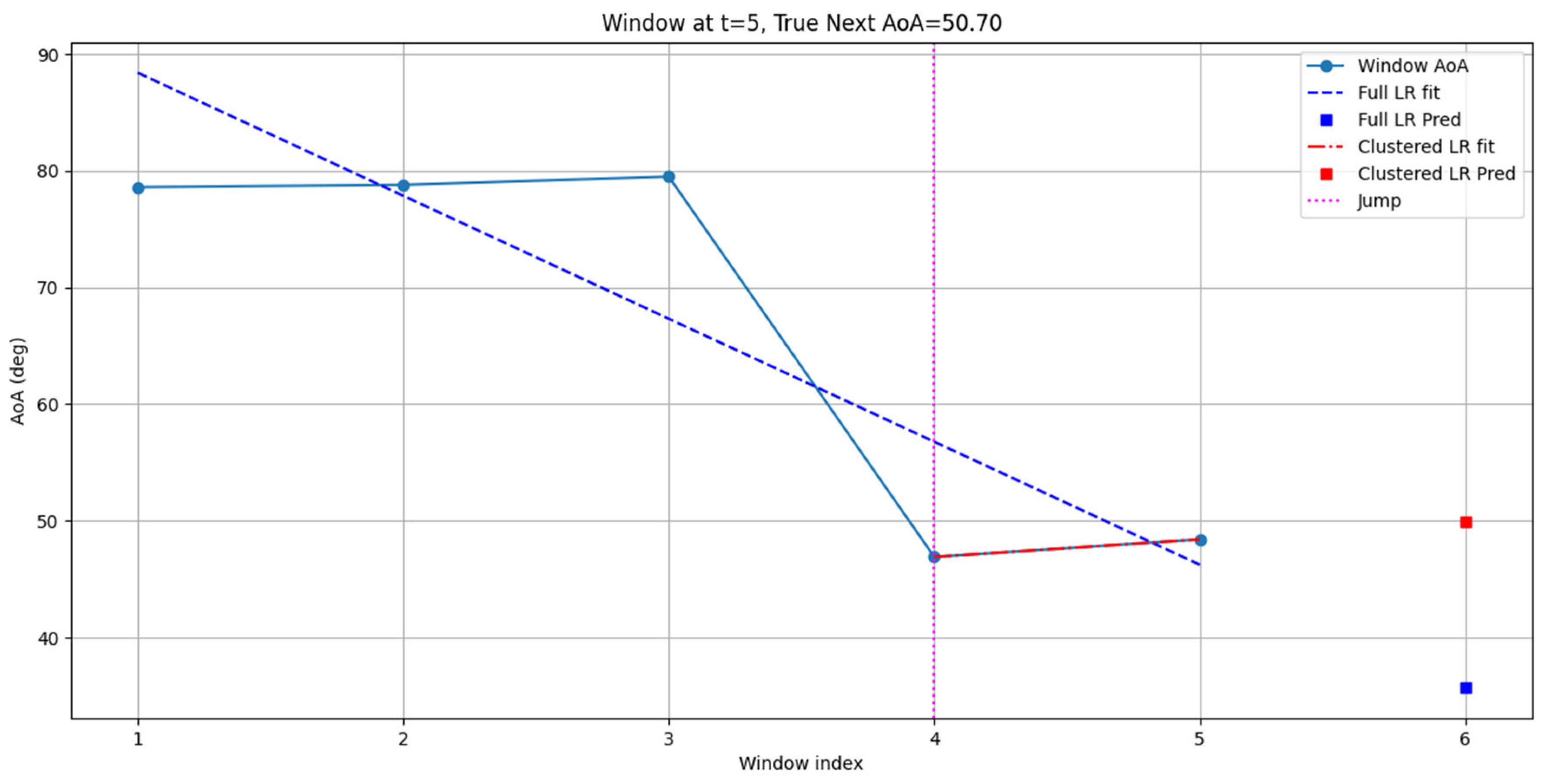
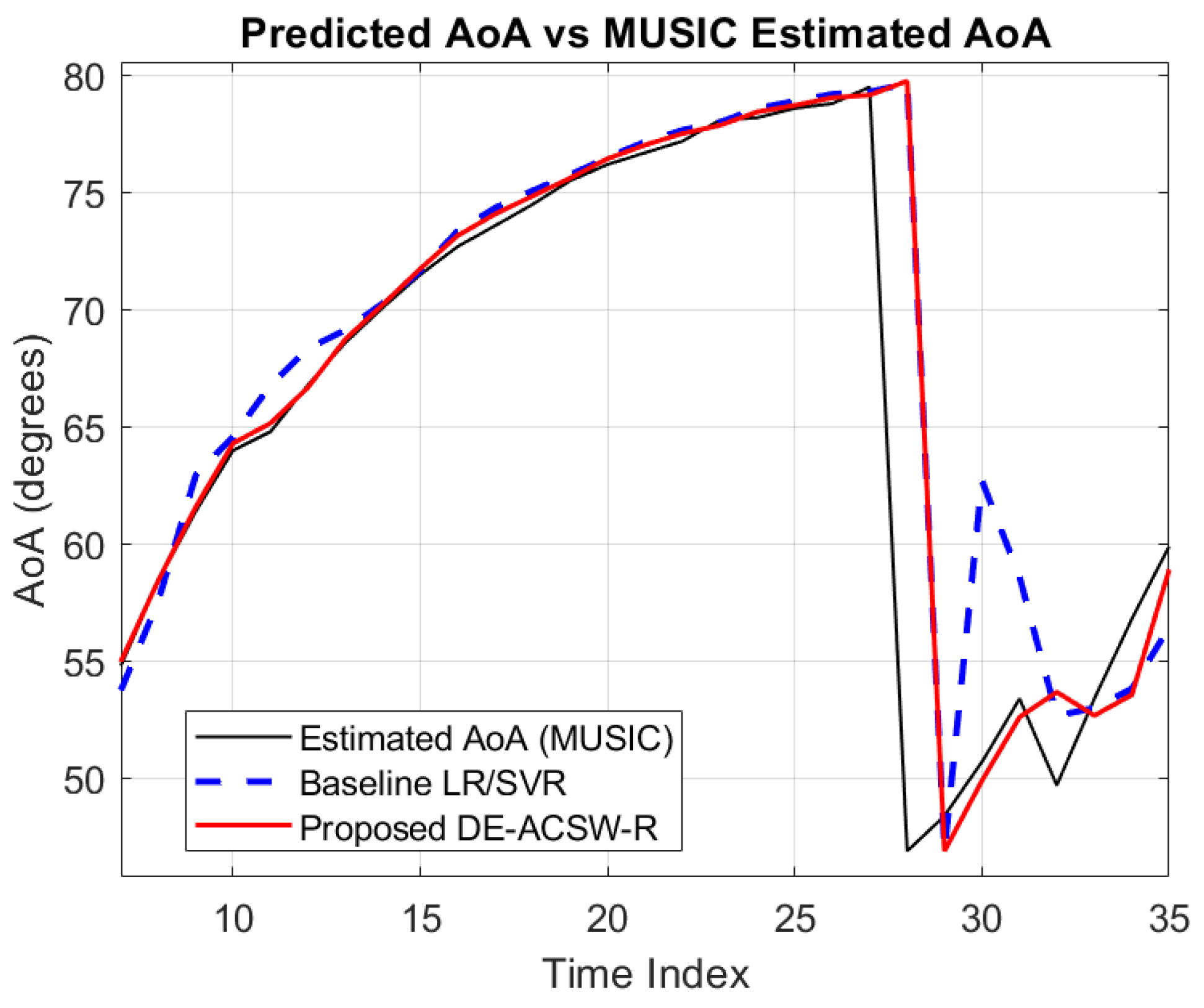
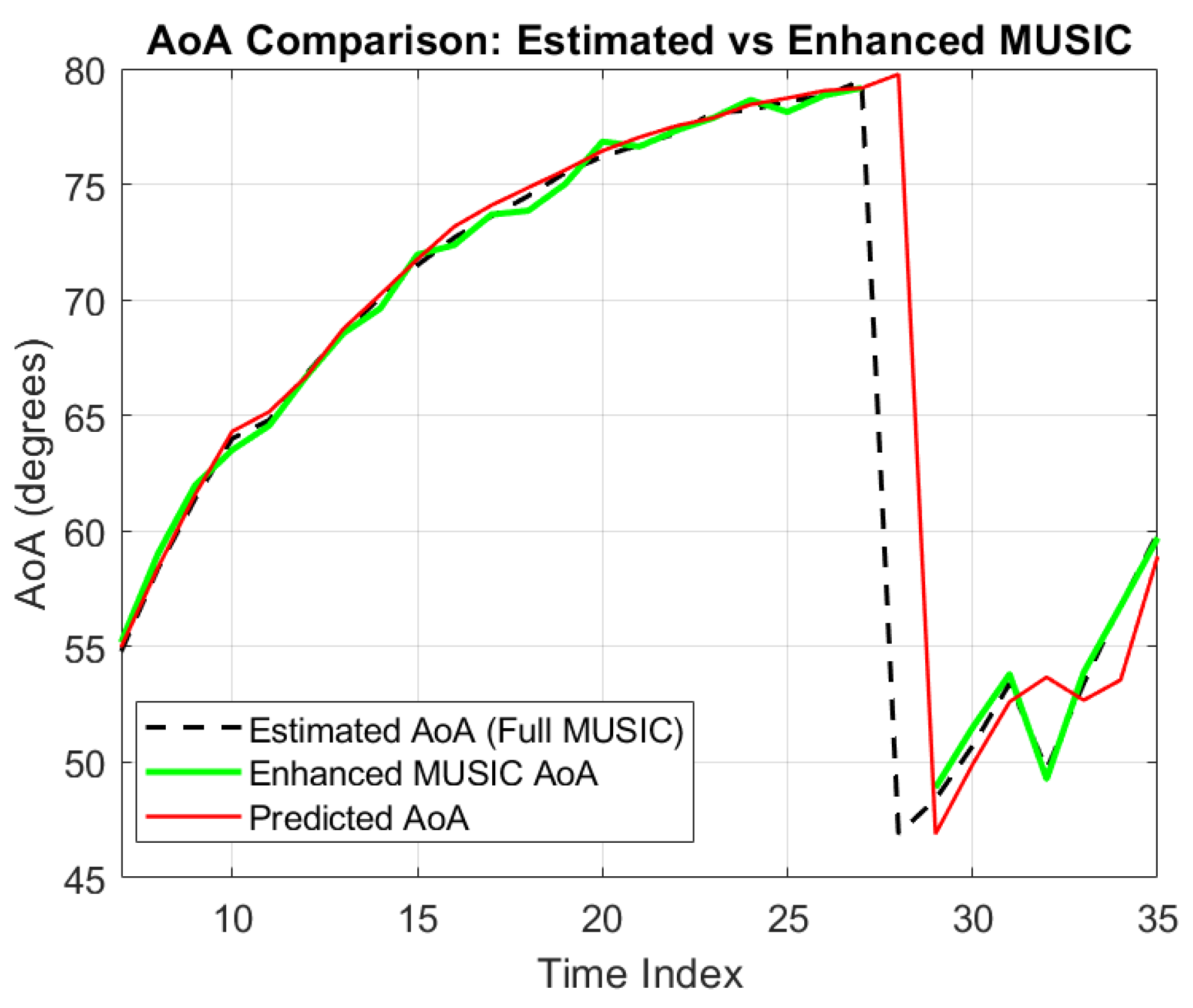
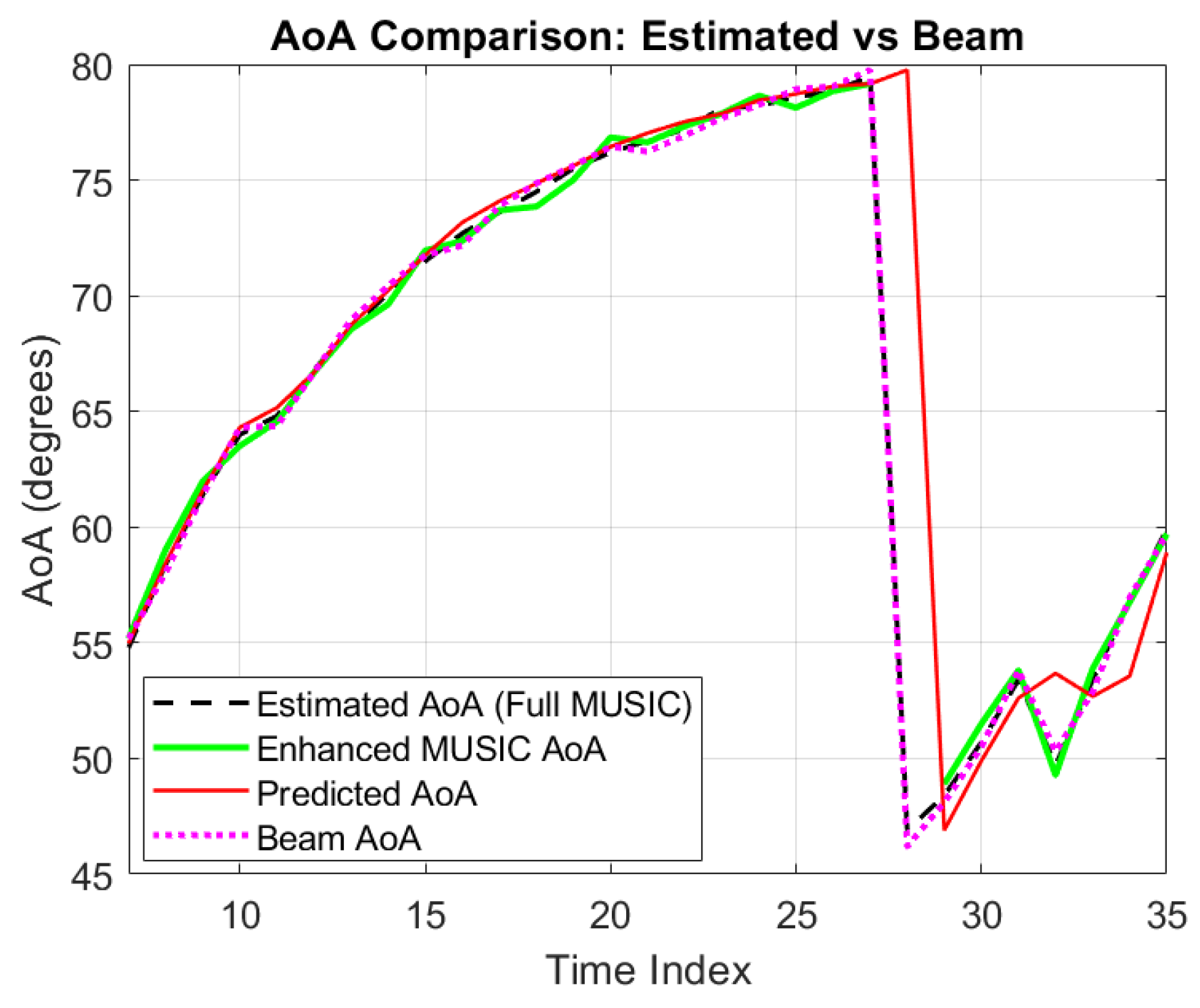

| Reference | Methodology | Key Contributions | Limitations | Comparison with DE-ACSW-R |
|---|---|---|---|---|
| [20] Spanos et al. | MUSIC (SRS-based) | High-resolution AoA estimation | Lacks predictive and latency-sensitive real-time beam steering | DE-ACSW-R incorporates predictive modelling for proactive beamforming |
| [21] Elsisi et al. | Computationally Efficient 2D MUSIC | Reduced complexity for static scenarios | No predictive mechanism, limited mobility handling | DE-ACSW-R provides dynamic clustering and adaptive prediction, suitable for non-linear mobility |
| [22] Shan et al. | SVR with Chaos Mapping | Improved SVR predictive capability | Lacks AoA predictive modelling in mobile scenarios | DE-ACSW-R leverages SVR with curvature-adaptive kernels for wireless AoA |
| [23] Mohamed et al. | ML-based beam selection | Optimises beam selection and timing | Lacks distributed integration, no direct AoA modelling | DE-ACSW-R integrates directly into O-RAN with distributed inference |
| [24] Al-Shehri et al. | Low-complexity ML beam prediction | Effective low-latency prediction | No fallback mechanism, static kernel | DE-ACSW-R provides dynamic adaptation and MUSIC-based fallback mechanisms |
| [25] Jin et al. | Neural network-driven AoA estimation | Enhances accuracy under multipath | Deep learning overhead, lacks low-latency deployment | DE-ACSW-R avoids overhead through adaptive regression and real-time prediction |
| Parameter | Value/Range |
|---|---|
| Carrier Frequency (fc) | 5.9 GHz |
| Number of Antenna Elements (N) | 8, 16, 32 |
| Antenna Height | 20 m |
| Number of Users (U) | 1–8 |
| User Height (fixed) | 1.5 m |
| Antenna Spacing (d) | λ/2 |
| Snapshots (T) | 20, 100, 1000 (per scenario) |
| Time Interval (t) | 1 ms–160 ms |
| User Initial Distance | 10 m |
| User Distance | 150–200 m |
| User Speed | 30 km/h and 50 km/h |
| SNR Levels | 0–30 dB |
| Number of Multipath (M) | 3 per user |
| Window Size | 5 (with tests at 10 and 20) |
| AWGN Power | 8.004 × 10−13 W (calculated for TH_noise = 290 K, B = 20 MHz) |
| Rayleigh Fading | Variance = 0.8, Mean = 0 |
Disclaimer/Publisher’s Note: The statements, opinions and data contained in all publications are solely those of the individual author(s) and contributor(s) and not of MDPI and/or the editor(s). MDPI and/or the editor(s) disclaim responsibility for any injury to people or property resulting from any ideas, methods, instructions or products referred to in the content. |
© 2025 by the authors. Licensee MDPI, Basel, Switzerland. This article is an open access article distributed under the terms and conditions of the Creative Commons Attribution (CC BY) license (https://creativecommons.org/licenses/by/4.0/).
Share and Cite
Mayyahi, M.; Mongay Batalla, J.; Żurek, J.; Krawiec, P. Distributed Prediction-Enhanced Beamforming Using LR/SVR Fusion and MUSIC Refinement in 5G O-RAN Systems. Appl. Sci. 2025, 15, 7428. https://doi.org/10.3390/app15137428
Mayyahi M, Mongay Batalla J, Żurek J, Krawiec P. Distributed Prediction-Enhanced Beamforming Using LR/SVR Fusion and MUSIC Refinement in 5G O-RAN Systems. Applied Sciences. 2025; 15(13):7428. https://doi.org/10.3390/app15137428
Chicago/Turabian StyleMayyahi, Mustafa, Jordi Mongay Batalla, Jerzy Żurek, and Piotr Krawiec. 2025. "Distributed Prediction-Enhanced Beamforming Using LR/SVR Fusion and MUSIC Refinement in 5G O-RAN Systems" Applied Sciences 15, no. 13: 7428. https://doi.org/10.3390/app15137428
APA StyleMayyahi, M., Mongay Batalla, J., Żurek, J., & Krawiec, P. (2025). Distributed Prediction-Enhanced Beamforming Using LR/SVR Fusion and MUSIC Refinement in 5G O-RAN Systems. Applied Sciences, 15(13), 7428. https://doi.org/10.3390/app15137428







